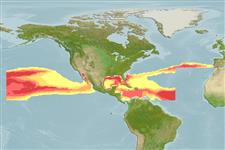>
Lophiiformes (Anglerfishes) >
Oneirodidae (Dreamers)
Etymology: Oneirodes: Greek, 'oneiros' = a dream or dreamlike or out of a dream (suggesting this fish is so strange and marvelous that can exist only in dreams) (Ref. 86949).
More on authors: Regan & Trewavas.
Environment: milieu / climate zone / depth range / distribution range
Ecologia
marino batipelagico; distribuzione batimetrica 0 - 1000 m (Ref. 86949). Deep-water; 40°N - 10°N
Eastern Central Atlantic: Off Azores. Western Central Atlantic: Caribbean Sea. Eastern Central Pacific: Off Hawaii.
Size / Peso / Age
Maturity: Lm ? range ? - ? cm
Max length : 2.7 cm SL (female)
Short description
Chiavi di identificazione | Morfologia | Morfometria
Raggi dorsali molli (totale) : 5; Raggi anali molli: 4. Characterized by having escal morphology: esca with anterior appendage short and stout, not longer than escal bulb, bearing a fringe of filaments on lateral margin near base and a single unbranched filament on anterior margin; stout, forked medial escal appendage, more than three times length of escal bulb, bearing 4-5nshort branches near base; left fork of medial appendage with 2 relatively short branches; unbranched fingerlike posterior escal appendage shorter than escal bulb; lateral and anterolateral escal appendage absent; subopercle short and broad, without indentation on posterodorsal margin; length of ventral fork of opercle 24.2-24.7% SL; ratio of lengths of the dorsal and ventral forks of opercle 0.37-0.45; absence of epibranchial teeth; presence of teeth on pharyngobranchial II; upper jaw teeth 18-38, lower jaw teeth 31-44; teeth on vomer 6-7; dorsal fin rays 5; anal fin rays 4; pectoral fin rays 15-17; head length 40.8-45.4% SL; head depth 33.3-42.2% SL; premaxilla length 29.6-36.3% SL; length of lower jaw 46.3-51.5% SL; length of illicium 15.1-22.2% SL (Ref. 86949).
Few specimens (Ref. 10523).
Life cycle and mating behavior
Maturities | Riproduzione | Spawnings | Egg(s) | Fecundities | Larve
Bertelsen, E., 1986. Oneirodidae. p. 1383-1399. In P.J.P. Whitehead, M.-L. Bauchot, J.-C. Hureau, J. Nielsen, and E. Tortonese (eds.) Fishes of the North-eastern Atlantic and the Mediterranean. UNESCO, Paris, Vol. 3. (Ref. 10523)
IUCN Red List Status (Ref. 130435)
Threat to humans
Harmless
Human uses
Strumenti
Special reports
Download XML
Fonti Internet
Estimates based on models
Preferred temperature (Ref.
123201): 10 - 22.2, mean 15.2 °C (based on 70 cells).
Phylogenetic diversity index (Ref.
82804): PD
50 = 0.5000 [Uniqueness, from 0.5 = low to 2.0 = high].
Bayesian length-weight: a=0.01995 (0.00906 - 0.04395), b=3.01 (2.83 - 3.19), in cm total length, based on all LWR estimates for this body shape (Ref.
93245).
Trophic level (Ref.
69278): 3.3 ±0.6 se; based on size and trophs of closest relatives
Resilienza (Ref.
120179): Alto, tempo minimo di raddoppiamento della popolazione meno di 15 mesi (Preliminary K or Fecundity.).
Fishing Vulnerability (Ref.
59153): Low vulnerability (10 of 100).
